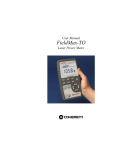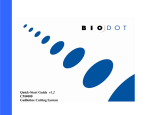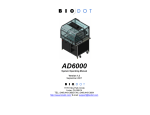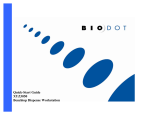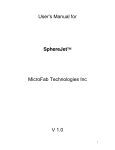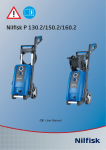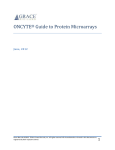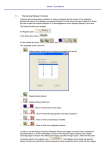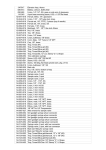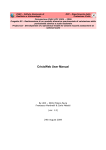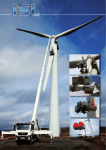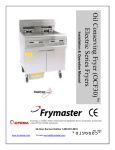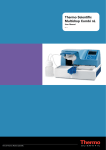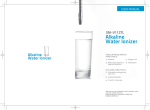Download Effective Low Volume Dispensing
Transcript
Application Note Effective Low Volume Dispensing using BioJet Quanti and BioJet Plus Dispensers Table Of Contents Introduction 1 Section 1: The Dispenser 2 Section 2: Dispensing Environment 4 Section 3: The fluid, including rheology, dissolved gases and particulate content 5 Section 4: The substrate 6 Section 5: Programming and Process Design 7 Section 6: Dispenser Maintenance 10 Summary: Considerations for Effective Nanoliter Dispensing 11 Appendix 12 Summary 15 Introduction Robust dispensing of fluids in low nanoliter volumes is a technically demanding process involving multiple variables. This document is designed to help the user understand how to effectively and robustly dispense low nanoliter volumes using the BioJet Plus dispensing system. The primary system components contributing to an accurate and reproducible low volume dispense are: 1. The dispenser 2. The environment 3. The fluids in the system 4. The substrate to be dispensed onto 5. Programming and process design factors 6. Dispenser cleaning and maintenance factors Each of these system components will be discussed in detail in this document. Section 1: The Dispenser through the tip orifice and ejects as a drop (or stream The BioJet Plus technology combines the high-resolution displacement capabilities of a syringe pump with a highspeed micro solenoid valve. This combination permits the non-contact dispensing of nanoliter volumes. if the amount of fluid is large). One valve actuation results in one drop. The key to a correct volume being dispensed in a given drop from the BioJet Plus system is the steady-state pressure (SSP) in the dispensing system. This pressure has several important features: BioJet Plus Valve TM • It is achieved by the displacement of fluid by the BioJet Plus Valve syringe pump TM • The SSP is displacement (drop size) dependent, increasing with increasing displacement (drop size) Ceramic Sensor Cards Figure 1 - BioJet Plus Dispensing System In a typical dispensing system, 4 to 8 of these syringe/ solenoid channels are placed together. Two modes of liquid handling are possible: Continuous (bulk) dispensing and aspirate/dispense. Continuous dispensing involves pulling reagent or solvent from a reservoir into the syringe and then dispensing it through the micro solenoid valve. Filling the system with a backing fluid, dipping the tip of the valve into a sample, withdrawing the syringe to aspirate the sample, and then dispensing the aspirated sample accomplishes Aspirate/ dispense. The BioJet Plus™ dot dispensing system is a hydraulically driven system that requires a fluid medium to be present from the syringe to the microsolenoid BioJet Plus™ valve. The dispensing process involves the following steps: 1) The syringe is displaced a given amount 2) The valve is opened for a short period of time (milliseconds) 3) Fluid is released from the valve and travels to the tip 4) The fluid increases its linear velocity as it passes Effective Low Volume Dispensing using BioJet Quanti and BioJet Plus Dispensers • The SSP is determined by the system compliance, which is dominated by entrapped air bubbles. • Once the SSP is established, the amount of fluid displaced by the syringe pump will equal the amount dispensed The BioJet Plus™ dot dispensing system can be modeled as an electrical circuit with the pressure acting as the voltage, the flow rate as the current, the system compliance as capacitive elements, the valve, tip, and feed lines as resistive elements, and the valve as a switch. This model shows the syringe pump as a current source, which provides an advantage over a pressure source (e.g. gas pressure) in that any changes in resistance will not affect the flow rate. In contrast a pressure source will be affected by changes in resistance in the system. Factors Affecting the Dispense Volume The model described above shows the fluidic circuit possessing a feedback loop, which can be used to achieve the SSP. Once the SSP has been achieved, the volume displaced will equal the volume dispensed. The SSP is achieved by first pre-pressurizing the system by displacing an experimentally determined volume using the www.biodot.com Application Note xxxxxx syringe pump. Usually this pre-pressure is slightly higher vent, which opens the microsolenoid valve without displacing than the required system pressure and requires several any fluid. When sample is aspirated, the syringe pump draws pre-dispenses at the desired volume to reach steady fluid through the tip orifice. The resistance to flow from the tip state pressure, whereby the desired dispense volume is and valve creates a negative pressure, which must first be dispensed. overcome to achieve a steady state pressure. Several factors influence the achievement and maintenance As with priming, venting the system can bring the system to of the SSP and the desired dispense volume: a known (zero/ambient) pressure, from which the SSP can be applied (Note: venting is typically done with tips in the Priming sample to prevent the introduction of air). The Prime is used to initialize the syringe pumps and fill the syringe pumps, microsolenoid BioJet Plus valves of the dispense head, and connecting tubing with fluid from The SSP during a prime/aspirate/dispense cycle is shown the reservoir(s). The reservoir fluid is either system fluid for schematically below: aspirate/dispense of reagent, or sample fluid for continuous (line or dot) dispensing. When the dispense system is primed, several hundred micro liters of fluid are dispensed as a stream. The resistance to flow caused by the valve and tip orifice causes the pressure within the system to become higher than desired for SSP. To achieve SSP, one must first vent the valves, which involves opening the valves without displacing fluid. This brings the system to ambient (zero) pressure and from this point; the SSP pressure can be achieved. Aspiration The aspirate function draws sample from a reservoir, usually a micro-well plate, into the tip of the dispense head. To perform an aspirate, several parameters must be set. These parameters are set by using Syringe Speed and Gas Bubbles Gas bubbles can occur in the dispensing system for Channel Parameter actions. The syringe speed controls multiple reasons, including primarily leaks and dissolved the speed of the syringe pump dispensers. In general, gases in the fluid. The major effect of bubbles is to change slow syringe speeds are used for aspiration to prevent a the system compliance, which can affect drop formation. large vacuum from being developed which can result in the Input will still equal output but the fluid will collect on the development of bubbles in the system. dispense tip rather than eject as a full drop. This can cause During the normal aspiration process, a slight negative pressure variation in dispensed volumes and eventually cessation of is produced. This negative pressure is relieved by performing a dispensing. www.biodot.com 3 Bubbles can be removed by purging the system with For a dispense system at SSP, the proper open time will isopropanol and using degassed solvents as well as the result in a displaced volume equal to the dispensed volume. system fluid. If the open time is too short, then over time pressure will build beyond the SSP. If the open time is too long, the SSP Tip Effects will be dissipated eventually resulting in drops not being Condensation of liquid on the dispense tips can lead to ejected from the tip. loss of control of dispense volumes due to the interaction of ejected drops with resident fluids near the tip orifice. The open time is the approximate time required for the This effect can be reduced and/or eliminated by vacuum fluid to move though the valve. Thus open time increases drying of the tips at appropriate times during the dispense with increasing drop size and increasing viscosity. A list cycle. Vacuum drying the tips is especially important when of appropriate on-times is contained in the dispenser dispensing for long periods of time. Tip orifice size is also manual. of critical importance. Smaller drop sizes require smaller properties of the fluid and the particulate content of the fluid Section 2: Dispensing Environment to be dispensed, as smaller orifices clog more easily than Many dispensing applications require careful control of the larger orifices. dispensing environment. This can entail control of : orifice sizes for proper drop formation. The smaller orifice size must, however, be balanced against the rheological • Humidity Syringe Speed • Static electricity Syringe speed is the speed of displacement of the fluid in • Partial pressure of solvents or noble gases the syringe pump. For dispensing, the syringe speed has • Airborne particulates little if any affect on the SSP. For priming, the syringe speed The use of environmental enclosures around machines will effect the pressure build-up and at very high speeds, can be critical in ensuring proper and continuous operation may cause too much pressure and result in leaking. For of the machine. The use of controlled, elevated humidity aspiration, slow speeds are best to prevent excessive environments can be important in aspirate and dispense negative pressures being generated, which could also lead applications where open reservoirs of small volumes of to out-gassing from the fluids. aqueous reagents are used as the source for dispensing. Slightly elevated humidity can also help to reduce the Valve Open Time buildup of static electricity which can be caused by the The microsolenoid BioJet Plus valve open-time is one of the movement of certain substrates such as nitrocellulose most important parameters for achieving and maintaining through the unit. the SSP. This is the time the valve opens to release displaced fluid and eject the drop. In previous versions of Increased partial pressures of noble gases can be used to software the open time is set in % duty cycle. Duty cycle assist in reduction of oxidation of reagents, as well as to gives the percent of time the valve is open for one valve control drying, and increased partial pressures of solvents actuation and the open-time is the actual amount of time in the chamber can be used to reduce evaporation of that the valve is open in one valve actuation. solvent-based reagents within safe operating parameters Effective Low Volume Dispensing using BioJet Quanti and BioJet Plus Dispensers www.biodot.com Application Note xxxxxx for the solvents (the possibility of flash must be particularly Dissolved Gases considered where use of this option is intended). The presence of dissolved gases in the system can lead to inaccuracies in dispense volume or missed dispenses. Critical to the continued trouble-free operation of the Dissolved gases can come out of solution at virtually any machine is minimizing the particulate content of the entire point in the system that a nucleation site is available, which area in which the dispenser operates. Ideally, the unit includes the inlet and outlet lines, the syringe, the three- should be operating in a Class 10,000 or better cleanroom port valve and the BioJet valve and tip. These bubbles may with temperature and humidity control. At worst the machine be macro-scale and be visible to the eye, or they may be should be enclosed to reduce the possibility of airborne microscopic or in a portion of the fluid pathway that is not contamination of the dispensing area with high levels of visible to the operator, thereby making it extremely difficult to particulates which can serve to disrupt the operation of the diagnose a dispensing issue when one arises. It is therefore BioJet valve. critical to remove as much dissolved gas from the fluid as possible prior to use in the dispenser. This degassing can Section 3: The fluid, including rheology, dissolved gases and particulate content be achieved in a number of ways. BioDot recommends the use of helium degassing (described elsewhere in this document) but in cases where the required equipment is not available, a less efficient method of vacuum degassing may be used. All fluids that come into contact with the dispenser Fluid Rheology should be degassed and filtered, including backing fluids. Since there are constricted passageways within the BioJet Quanti3000™, the flow of liquid is influenced by Particulate Content both the viscosity and surface tension of the dispensed BioJet valves operate in part through the motion of a poppet reagent. Fluids of viscosity up to approximately 10cP can which is seated in a rubber seal. When the poppet is in be accurately dispensed, however for ideal results, fluid the up position, the fluid pathway is open and fluids pass viscosity greater than 4 centipoise should be avoided since through the valve opening to the tip under pressure. When drop to drop variations are more likely to occur under these the poppet is in the seated position, the valve is closed and conditions. Highly compressible fluids or fluids demonstrating no fluid passes through to the tip. Correct seating of the thixotropic properties must be used with care in the system. poppet in the EPDM seal is one element of the operation of In aspirate and dispense applications, it is critical that the the system that ensures that the SSP is maintained, that no backing fluid used in the system be compatible with the fluid air enters the system, and that no fluid leaks from the system. to be dispensed. The use of incompatible backing fluids If particulates become embedded in the rubber seal, they can result in chemical reactions, leading to the formation physically inhibit the proper seating of the poppet in the seal, of particulates, air bubbles, or filaments, any one of which thereby ensuring that all of the problems just described will is potentially disastrous to the application and to the BioJet occur. The presence of microscopic particulates in the valve valve. Certain fluids also contract on contact with water, seal is the number 1 cause of poor dispense quality and leading to changes in volume that can affect the accuracy valve failure. Additionally, particulates can cause damage and reproducibility of dispensing. to syringe seals, 3-port valves, and can provide nucleation points for bubble formation in the system. www.biodot.com 5 It is critical that all fluids used in the system be filtered aspiration volume is needed, a customized extension can before use, ideally with a 0.22um filter. This includes be added between the valve and the tip. This results in an reagents, backing fluids and wash fluids. BioDot can increase in the minimum dispense volume from 8 to 10 nL provide in-line filters to reduce the particulate load drawn up to 50 to 100 nL. A second option is the use of a more into the fluid pathway. inert valve. BioDot offers a more chemically inert valve, the performance of which can be assessed with the particular Chemical Compatibility solvent of interest on an individual basis. Aqueous Solvents In general, aqueous solvents are compatible with the BioJet dispensing technology. Buffers with a pH range from 3 to 10 are suitable. Extremes in pH may cause corrosion of the stainless steel or glass materials. In addition, many surfactants and proteins can be used with the dispensing system. Section 4: The substrate The physical characteristics of the substrate contribute a great deal to the quality and efficiency of a microdispense. Characteristics of the substrate that can compromise or contribute to a good quality result include: • Hydrophobicity • Planarity Polar Organic Solvents In general, polar oganic solvents are compatible with the dispensing system. Although not all polar organic solvents have been tested under long-term conditions, the following have shown good chemical compatibilty with the system: • Dimethyl sulfoxide (DMSO) • Acetone • Methyl Ether Ketone (MEK) • Ethyl acetate Non-Polar Organic Solvents Most non-polar organic solvents are incompatible with the Biojet dispensing technology. These solvents cause swelling and/or degradation of the polymeric parts of the microsolenoid valve, especially the EPDM seal. Overcoming Chemical Incompatibility In some cases, chemical incompatibilities can be overcome. For example, for samples dissolved in solvents which are not compatible with the standard BioJet valve, the sample can be aspirated up to but not into the valve (approximately 5 μL maximum aspiration volume). In cases where a larger Effective Low Volume Dispensing using BioJet Quanti and BioJet Plus Dispensers • Reproducibility of modification (additives or treatments) • Charge Through careful application of the principles described in this document, the BioJet or BioJet Plus dispenser can deliver a quantifiable, reproducible, programmable volume from the tip of the dispenser. Quite often, what that dispense looks like once it hits the substrate will depend largely on the qualities of the substrate itself. BioJets have been used to dispense on a wide variety of substrates, from glass slides to nitrocellulose, and a wide variety of plastics, both flexible and rigid. The quality of the dispense achieved can be measured in a variety of ways, and each application has different requirements for the aesthetics and volumetric accuracy to be achieved. Microarrays on glass slides or coated glass slides generally require a final spot with good morphology, perfect roundness and even density of deposition across the spot. The achievement of these characteristics depends on factors such as the hydrophobicity / hydrophilicity of the substrate, the (protein-) binding nature of the substrate, static charge, and wicking characteristics, as well as the rheological and www.biodot.com Application Note xxxxxx chemical characteristics of the fluid itself being dispensed. incompatible fluids, leading to errors in dispensing While it is relatively simple to optimize the volume of the accuracy or damage to valves. dispense, it quite often requires more demanding work to optimize the interactions of the reagent, substrate It is strongly recommended that users purchase an and dispenser to achieve the aesthetic characteristics Installation and Training package from BioDot, and / or desired in the final spot. Other applications, such as many utilize BioDot’s Application Laboratory and technical staff to biosensor designs, are less demanding in terms of spot develop their programs and applications at least initially. morphology after deposition, and demand more in terms of reproducibility of absolute dispense volume or coverage of The User Manual for the unit should be carefully studied, a defined area at a defined thickness. These applications and operators should pay particular attention to the sections have their own demands in terms of surface characteristics on Cleaning and Programming of the BioJet or BioJet Plus of the substrate, particularly wicking or spreading dispensers. characteristics, and tolerances on the placement of printed Some basic principles should be applied to process design circuits. Variations in z-axis height on some substrates in order to achieve maximum system performance: can cause issues with dispense placement accuracy, as 1. Pay particular attention to the geometry of the machine consistent z-axis placement of the tip relative to the surface and the dispense head in designing the process in is important for ensuring accurate drop positioning. order to minimize process time and to create intelligent process designs Section 5: Programming and Process Design 2. Determine early in the process design phase the optimal number of dispensers, balancing throughput, cost and process efficiencies 3. Consider fluid rheology and chemistry in determining 5.1 Introduction backing fluids to be used Great care should be taken during the initial stages of 4. Consider solvent compatibility with the BioJet valves learning the control software for the BioJet and BioJet 5. Determine whether humidity and temperature control Plus systems. It is estimated that over 90% of the userinduced damage to BioDot systems occurs within the first week of operation at a customer site. These are sensitive robotic instruments, which, while robust enough to handle demanding manufacturing and R&D environments when handled correctly, can be severely damaged through incorrect operation. Common errors include: • Crashing of heads through incorrect programming of the compound motion table or gantry • Damage to BioJet or BioJet Plus valves through incorrect programming of valve operation are required 6. Determine whether an increased atmospheric partial pressure of a solvent is required 7. Ensure that the backing fluid used is appropriate and compatible with the fluid to be dispensed 8. Think clean. Remove all sources of particulates in fluids, machine, disposables and parts to be dispensed 9. Use the sample programs provided with the machine to establish the basic program that you wish to use, then build complexity from there 10. Use sleep mode programs to prevent the need for continuous machine setup and teardown (see below) • Contamination of the system with particulates or www.biodot.com 7 5.2 In-Process Cleaning of Tips components of the fluid pathway. Buildup of proteins on tips can lead to inconsistent dispensing due to clogging, and also to carryover of A methodology for improving system performance through proteins from well-to-well of a source plate and array (if appropriate multiple samples are being aspirated in sequence using programming is outlined below. system setup, teardown, cleaning and the same tip). Appropriate in-process cleaning is crucial to maintaining dispenser function. 5.3.1 Purpose To outline a procedure for setting up a machine in order Depending on the type of protein, hydrophobic interactions to achieve consistent machine performance via degassing, can mean that protein adheres quite strongly to the tip and filtering, use of helium and sleep mode. removal of the protein from the tip can be difficult. Each system should be assessed separately, however as a general principal, the use of a buffered solution of MeOH (approximately 20%) plus 100mM NaCl, pH 7.4 (for example in Tris) will be adequate to disrupt binding of proteins to tips. Repeated immersion and aspiration of a cleaning solution such as this one, followed by rinsing with filtered distilled water should be sufficient to remove most proteins from the tips. This can be programmed as a periodic cleaning step in situations where a single sample is being dispensed repeatedly from a tip, or between samples. 5.3 Sleep Mode Programs 5.3.2 Materials • Any Biodot machine containing syringe pumps and BJQ’s – configuration will include Minstac • connections and ceramic tips • Tank of helium • Apparatus/manifold for connecting source reservoir to machine and helium tank concurrently • Filter - at least 0.45μm but 0.2μm preferred. If in-line filters on the fluid inlet lines are to be used, a larger filter size (1μm) is recommended in order to minimize effects on the rapid achievement of Steady State Pressure in the system. To maintain optimal system performance, it is advisable to minimize the number of times that the machine has to be shut down and restarted. Every time a shutdown and restart is performed, a cleaning and priming cycle is necessary, which often involves disconnection of syringes, tubing and valves, which in turn increases the opportunity for damage to components and can lead to increased opportunities for contaminants to enter the system. The use of Sleep Mode Programs is one way to minimize the number of setup and shutdown cycles. In this mode of operation, the system is left to idle when not in use, reactivating itself at intervals to dispense small amounts of innocuous fluids, cleaning fluids or backing fluids. The machine can then simply be reactivated when necessary, flushed and set up to run the required program without physical interference with the Effective Low Volume Dispensing using BioJet Quanti and BioJet Plus Dispensers 5.3.3 Methods 5.3.3.1 First time set-up The first time a machine is used (OR anytime ANY hardware is changed), it must be assumed that the fluid path (or hardware) contains particulates that may cause the dispensing valve to fail (either mechanically or functionally). It must also be assumed that air is present in the fluid path which will greatly impede consistent dispensing. Therefore, anything coming into contact with the backing solution must first be cleaned, the backing solution, wash solution and dispensing solution must be filtered and the fluid path cleared of air. These things can be accomplished by cleaning removable parts offline, filtering, and flushing with ethanol, respectively. www.biodot.com Application Note xxxxxx Cleaning Removable parts should be cleaned off-line (this will Vacuum Degassing • Using BioDot’s Reagent Degasser DG950, include the reservoir bottle, syringe and piston, in-line de-gas the reservoir bottle(s) using sonication filter, if being used, and ceramic tip). Once cleaned, for 10 minutes – sonication can be run in 10 reattach all parts. second intervals. • If this equipment is not available, apply a Filtering vacuum to the reservoir bottle(s) for at least 10 Filtration of dispense fluids, ethanol, backing fluids minutes. and wash fluids can be performed off-line via a bottle- • When the de-gassing is complete, DO NOT top filter or a syringe tip filter or in-line using BioDot’s pour the liquid into another container as this recommended in-line filter. will redissolve air into the liquid. Cover the bottle with a cap or wrap tightly with parafilm to Flushing transfer the bottle to the machine. Disconnect the Minstac fitting at the top of the dispensing valve(s) and position the end of the tubing over a waste basin – repeat this for all channels. Attach a reservoir Helium Degassing • Note: This procedure must be performed with bottle(s) containing filtered ethanol to the machine. BioDot’s helium degassing system. It is designed Prime the ethanol through the fluid path until all visible for use with fluids to be bulk dispensed (ie put air in the tubing is expelled and at least one more cycle through the fluid pathway, not aspirated) or with – this will clean the tubing as well as remove any air in backing fluids for aspirated fluids. the fluid path. • Fill reservoir bottle(s) with desired solution. • Apply 15 psig of helium to bottle(s) for 30 Then reattach the Minstac fitting to the dispensing valve(s) and make sure the ceramic tip(s) are in place – minutes. Vent to 0.1 psig. • repeat for all channels. To remove air from the dispensing valve(s) and tip(s), prime through with 2 more cycles of ethanol. The ethanol then needs to be removed from Repeat step 2 twice for a total of 3 fill and vent cycles. • Maintain an operating pressure of 0.1-0.2 psig helium for dispensing the fluid path which can be done by priming de-gassed backing solution (see below for procedure) through all lines. For most BioDot machines, 10 prime cycles will suffice to remove all the ethanol. 5.3.3.2 Machine Set-Up (Not First Time) Once the machine has been set-up according to the above Degassing outline, a clean and de-gassed state may be maintained by 1) All fluids entering the fluid pathway must be degassed. not changing hardware and 2) always maintaining a constant Below are two procedures for de-gassing using vacuum pressure of helium (i.e. the operating pressure). This means and helium. neither the machine nor helium will ever be turned off. When the reservoir needs re-filling, the helium will need to be turned off so the set-up procedure will begin at Filtering above. www.biodot.com 9 5.4 Sleep Mode The maintenance requirements of the controller and XYZ Good quality, consistent dispensing requires great attention motion system are minimal and these components of the to detail when setting the machine up for operation. The system rarely generate problems in terms of the quality factors above, achieving and maintaining a de-gassed of product produced. The fluid pathway is the portion of backing solution, filtering, cleaning and flushing, must all the system that requires the most care and attention, be addressed each and every time the machine is to be constant cleaning, and occasional maintenance and part used. In order to minimize the need to perform the above replacement. procedure, the machine should be placed in a “sleep mode” when not in use. An example of a Sleep Mode program is outlined below: The fluid pathway consists of: • Fluid reservoir (or source plate) • Move to Wash – places tips down into wash water. • Inlet tubing to the 3-port valve • Pause – Fixed duration of 15 minutes (900,000ms) • 3-port valve • Move – lift tips out of wash water • Syringe • Vacuum Dry Tips • Outlet tubing from the 3-port valve • Move to Waste • BioJet valve • Prime – 1 cycle (be sure to check for sufficient backing • Tip solution and to set appropriate syringe speeds) • Vacuum Dry Tips All portions of this pathway are considered to be disposables • Move to Waste and are subject to reduced warranty periods, so constant • Loop 50X - 100nL dispenses (be sure to include care must be taken to ensure long life and appropriate a syringe speed – 10-20-1000- and open time – performance. 1500ms) • Prime - 1 cycle In order to maximize life and minimize problems with This entire string should be within 1 function and that dispense accuracy, several basic principles should be function looped according to the following formula → # adhered to: hours machine will be unused * 60/15 minutes = # of time 1. Filter all fluids in the system, ideally with a 0.22um to loop function (or # of 15 minute cycles in total downtime). filter before use. This includes backing fluids, wash The “sleep mode” program then is simply this one function station fluids and fluids to be dispensed. If possible, looped x # of times. use in-line filters for fluids to be bulk-dispensed (i.e. not aspirated). Section 6: Dispenser Maintenance 2. Degas all fluids, ideally using helium degassing, or The BioJet and BioJet Plus dispensing systems consist of 3. Flush lines with alcohol regularly to reduce bubble three major components: • Controller using vacuum with intermittent agitation or sonication if helium is not available. formation 4. Work in a particulate-free environment. Ideally a class • XYZ motion (compound motion table or gantry) 10,000 or better cleanroom should be used. Remove • Fluid pathway particulates from reservoirs and machine before use Effective Low Volume Dispensing using BioJet Quanti and BioJet Plus Dispensers www.biodot.com Application Note xxxxxx 5. Rigorously and diligently follow all recommended cleaning procedures (see Appendix) 6. Check performance and be prepared to replace ALL Degas all fluids Ideally use helium degassing, or vacuum with intermittent agitation or sonication. fluid pathway components on a regular schedule 7. Use only compatible fluids within the BioJet valve (see Appendix for list of known incompatible fluids). All Follow BioDot’s cleaning procedures Use BioDot-specified cleaning materials and reagents. other fluids should be aspirated and dispensed from the tip and not put through the valve itself 8. Check performance of the system regularly using a calibrated measurement system such as the Artel Clean tubing separately from valves Disconnect the tubing from the BioJet valves before cleaning the tubing to prevent contaminants entering the valve. PCS (see Appendix for details) 9. Utilize “Sleep Mode” programs (see Process Design section. Never turn off the machine if possible Flush lines with alcohol regularly To reduce bubble entrapment in the fluid path. 10. Clean tubing separately from BioJet valves. If particulates accumulate in tubing they can be washed Check performance of the system regularly using a into the valve during cleaning of the system. Disconnect calibrated measurement system the tubing from the BioJet valves before performing Use a system such as the Artel PCS or a validated microtiter cleaning of the tubing. Subsequently reconnect the plate – based method tubing and clean the valves. Replace ALL fluid pathway components on a regular Summary: Considerations for Effective Nanoliter Dispensing schedule This includes: • Fluid reservoir (or source plate) • Inlet tubing to the 3-port valve Think clean • 3-port valve Remove all possible sources of particulates in the • Syringe environment, fluids, machine, disposables and substrates • Outlet tubing from the 3-port valve • BioJet valve Work in a particulate-free environment Where possible a class 10,000 cleanroom • Tip Use only fluids compatible with the valve All other fluids should be aspirated and dispensed and not Remove particulates from reservoirs and machine put through the valve itself before use Maintain the stability and uniformity of your reagents Foreign particles can damage both the 3 port valves and Operate in a temperature controlled environment or the solenoids. incorporate mixers, heating or cooling plates into the machine design Filter all fluids in the system before use Including backing fluids, wash station fluids and dispensed Choose source plates or reservoirs appropriate to the fluids. In-line filters can also be used. www.biodot.com 11 application. Consider: Prevent cross contamination of wells in source plates • Protein binding characteristics Clean tips carefully between aspirations. Ensure that the • Aspect ratio entire tip length exposed to the aspirate is washed before the • Capacity next aspiration to prevent carry-over of fluids. Use cleaning solutions appropriate to the reagents being handled. Choose the correct backing fluid for your application Consider fluid rheology and chemistry in determining backing fluids to be used Consider the physical characteristics of the substrate, Appendix 1. Cleaning of the BioJet Dispensing System including: • Hydrophobicity General Notes: • Planarity • All cleaning fluids must be filtered and degassed • Uniformity of modification • The cleaning method outlined here is valid for bulk • Charge dispensing of aqueous, proteinaceous reagents. It is a suggested protocol only. Users should validate their Maintain careful control of the dispensing environment, own protocol designed for use with their own particular including: application and reagents. • Humidity • If aspiration of multiple reagents using the same tip is • Static electricity being performed it is critical that the cleaning process • Partial pressure of solvents or noble gases be validated to ensure that no carryover of reagent • Airborne particulates from well to well occurs. It is likely that a solution such as MeOH (approximately 20%) plus 100mM NaCl, pH Take care in programming 7.4 (for example in Tris) will be adequate to disrupt Use the sample programs provided with the machine binding of proteins to tips, but depending on the to establish the basic program to be used, then build backing solution solvent used, this may require change complexity from there. and validation. • The cleaning protocols outlined are suggested for use Never turn off the machine if it can be avoided in systems where Sleep Mode programs are not used. Utilize “Sleep Mode” programs to minimize teardown and Daily Cleaning setup, which increase the likelihood of damage, introduction To achieve optimum performance and maximum life from of foreign particles and air into the system. the BioJet Quanti3000™ dispenser, it is recommended that the routine cleaning procedure listed below be followed Take care of your dispense head and tips during after each period of use (at least once daily). program development 1. Purge supply lines of reagent. Crashing of heads during program development is the main 2. Clean and refill the supply reservoir with deionized water source of damage to heads and tips. containing 0.05% BioTerge to enhance scrubbing of interior recesses within the BioJet Quanti™. 3. Prime dispenser for 5 syringe cycles. Effective Low Volume Dispensing using BioJet Quanti and BioJet Plus Dispensers www.biodot.com Application Note xxxxxx 4. Repeat steps 1 through 3 with deionized water. clean protein buildup from the lines and the valve. 1) Purge supply lines of reagent The reagent reservoirs and feed lines are reusable and may be used for extended periods of time before replacement is warranted. 2) Prime 3 cycles of deionised water with 0.05%. BioTerge through the system. 3) Prime this solution out of the system. 4) Prime Jetwash into the system and allow to sit in the Residue Cleaning (Weekly Cleaning during heavy use) BioJets for 30 minutes. After prolonged dispensing of reagents, some buildup 5) Prime this solution out of the system. of protein constituents, salts, latex materials, or other 6) Clean and refill the supply reservoir with deionized particulate matter may occur. It is recommended that the water. following cleaning steps be followed on a weekly basis 7) Prime dispenser for 5-10 syringe cycles. to dissolve any accumulated materials. This should be 8) Remove the glass syringe from the syringe pump. performed in addition to the daily cleaning procedure. 9) Remove the plunger from the syringe and flush deionized water through the open syringe and wash Option 1 1. Purge supply lines of fluids. the plunger in deionized water being careful not to damage the plunger seal. 2. Clean and refill the supply reservoir with a dilute base 10) Flush deionized water through the ports in the 3-port (0.1N NaOH). Prime the BioJet Quanti™ for 5 syringe valve. The valve stem may be turned by hand to switch cycles and allow to sit for 10 minutes. path positions. 3. Prime using deionized water as in steps 1 and 2 above. Cleaning of tips 4. Clean and refill the supply reservoir with a dilute acid Ceramic tips may be removed from the dispenser and (0.1N HCl). Prime the BioJet Quanti™ for 5 syringe washed in 1-10N acid followed by an equal molarity base, cycles and allow to sit for 10 minutes. in turn followed by flushing with water. Appropriate safety 5 Purge the supply lines and prime for a minimum of 10 cycles using deionized water. Option 2 For use in systems dispensing proteinaceous fluids or precautions should be observed when handling high molarity acids and bases. 2. Chemical Compatibility with the BioJet Dispensing Technology where acid/base use is undesirable Introduction This procedure may be performed as part of the regular The BioJet™ dispensing technology, can be used with weekly cleaning protocol in addition to Option 1 above or a wide variety of solvents and reagents. However, there as an alternative if the use of acid / base is undesirable in exist a limited number of solvents and reagents that can your system. It is of particular value in potentially damage the system. This application note examines the extent of chemical compatibility of a system helping to prevent cross-contamination when dispensing using the BioJet dispensing technology. multiple reagents from a single BioJet Quanti3000™, or to www.biodot.com 13 Wetted Materials dispensing system. Although not all polar organic solvents The materials which come in contact with fluids in the have been tested under long-term conditions, the following dispensing system are listed below: have shown good chemical compatibilty with the system: • Dimethyl sulfoxide (DMSO) Syringe Pump • Acetone • Teflon • Methyl Ether Ketone (MEK) • Glass • Ethyl acetate • Stainless Steel Non-Polar Organic Solvents Microsolenoid Valve Most non-polar organic solvents are incompatible with • Stainless Steel (430F, 316SS) the Biojet dispensing technology. These solvents cause • Polyphenylene Sulfide (PPS) swelling and/or degradation of the polymeric parts of the • Poly Ketone microsolenoid valve, especially the EPDM seal. • Ethylene/Propylene Diene Mono (EPDM) • Epoxy (minimal wetted area) Overcoming Chemical Incompatibility In some cases, chemical incompatibilities can be overcome. Other Parts For example, for samples dissolved in solvents which are • Teflon (transfer lines) not compatible with the microsolenoid valve, the sample • PEEK (fittings) can be aspirated up to but not into the valve (approximately • Polypropylene or Ceramic (dispensing tip) 5 μL maximum aspiration volume). In cases where a larger aspiration volume is needed, a customized extension can For continuous dispensing, the fluid wets all of the above be added between the valve and the tip. This results in an materials. For aspirate/dispense, the fluid comes in contact increase in the minimum dispense volume from 8 to 10 nL with the dispensing tip (aspiration volume < 6 μL) and the up to 50 to 100 nL. microsolenoid valve (aspiration volume > 6 μL) Chemical Compatibility Aqueous Solvents In general, aqueous solvents are compatible with the BioJet dispensing technology. Buffers with a pH range from 3 to 10 are suitable. Extremes in pH may cause corrosion of the stainless steel or glass materials. In addition, many surfactants and proteins can be used with the dispensing system. Polar Organic Solvents In general, polar oganic solvents are compatible with the Effective Low Volume Dispensing using BioJet Quanti and BioJet Plus Dispensers www.biodot.com Application Note xxxxxx Summary The following table shows the compatibility of various solvents and reagents: For specific solvents not listed here, please inquire as to possible testing of the solvent. BioDot Inc. 17781 Sky Park Circle, Irvine, CA 92614 USA - T: 949.440.3685 - F: 949.440.3694 BioDot Ltd. The Kingley Centre, West Stoke, Chichester, West Sussex, PO18 9HJ UK - T: + 44 1243 57 2044 - F: + 44 1243 57 5752 www.biodot.com 15















